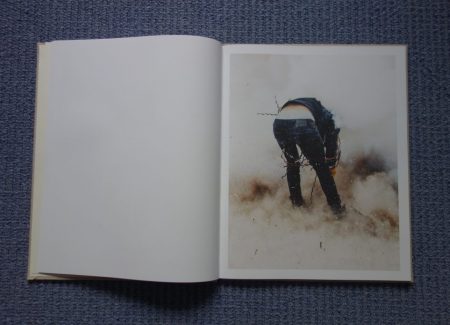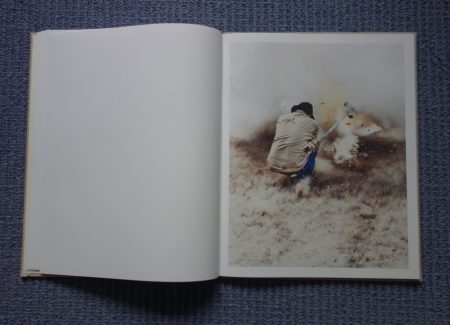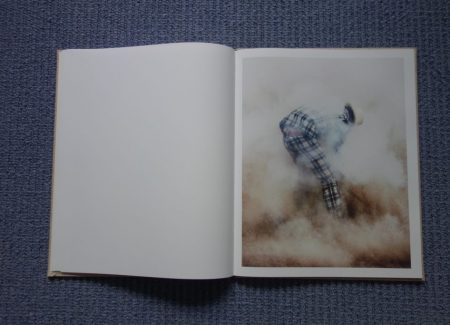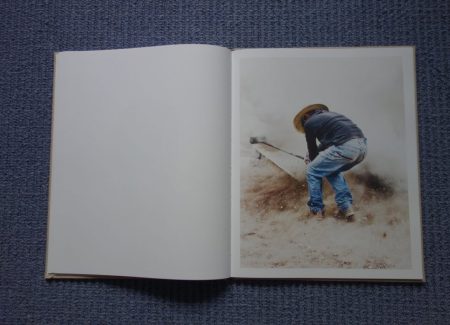JTF (just the facts): Self published in 2016 (here). Hardcover, 52 pages, with 23 color reproductions. There are no essays or texts included. In an edition of 250 copies. (Cover and spread shots below.)
Comments/Context: Since the very invention of photography, the medium has been exhaustively used to document the nuances of human movement. From the meticulous stop motion studies of Muybridge, Marey, and Edgerton to the unique gestures to be found on the streets, in the dance studio, on playing fields, in loving embrace, and in the angry chaos of war, the collective effort of countless photographers past and present has led to a dizzying array of subtleties discovered in the movements of people. But just when we might begin to think that such a subject might be tapped out, an unexpected photobook like Thomas Prior’s Bomba comes along, reminding us that the motion of the human body still has plenty of remarkable photographic potential.
Bomba offers no explanatory text or background essay, so the book deliberately asks us to engage with its mysterious pictures without the benefit of an obvious context or social framework. Each of Prior’s images is structured in exactly the same way – a single male figure wields a heavy sledgehammer, and each picture captures the split second aftermath of an explosive smash, where clouds of dirt and white smoke engulf the recoiling form. And while a bit of journalistic digging can explain that these pictures were taken at an annual festival in the small Mexican town of San Juan de la Vega, and that the explosions were created by strapping fertilizer-based explosives to the heads of sledgehammers and slamming them against lengths of steel rail, this battle recreation isn’t what gives the pictures their vitality. The real fascination to be found in these photographs is how they unlock the momentary intensity of forceful movement.
Rineke Dijkstra has famously made portraits of people at moments of exhaustion (mothers after giving birth, bloodied bullfighters just outside the ring etc.) in the hopes of seeing them with a measure of true authenticity, when their guard is down and they are unable to consciously mask themselves in front of the camera. Robert Longo tried something similar years earlier, throwing tennis balls at his stylishly dressed friends on New York rooftops and photographing their protective reactions and twisting evasions. So in many ways, Prior’s pictures follow along this same conceptual path – in the midst of a cacophonous and clearly dangerous explosion, it’s hard to put on a fake smile or a mannered pose.
What we see instead are isolated bodies tossed and unbalanced by unseen forces, grown men blown backwards, bent over, tumbling down, and exerting all the energy they can, only to be overwhelmed by something even stronger. And amid these momentous blasts, Prior finds surprising fragments of balletic grace, the machismo of the muscular display transformed into reverberating elemental form. Baggy jeans, work gloves, cowboy hats, army fatigues, and plaid suits provide a few individual touches, but anonymity (the consistent lack of faces) and ambiguity (the choking embrace of the surrounding dust and debris) turn the specific into the universal. Prior brings us back to looking closely at bodies, where squatting legs, tensed shoulders, extended arms, and flying hair tell overlooked stories, and each raised hand or curved back is a clue to human instinct and reaction.
The spare design of Bomba very much contributes to the success of the photographs. Large reproductions fill the right side of each spread, the expansive whiteness adding to the isolation of the forms and extending the path of the encroaching smoke. Each page turn offers another typological example, encouraging back-and-forth comparison and categorization. And a simple cloth cover with an embossed sledgehammer synthesizes the contents into a single resonant symbol. There is nothing extra here, nothing superfluous, and no distractions from the rhythms provided by the images, and that consciously pared down style channels our attention right where Prior wants it.
While there is something quietly ridiculous about this self-inflicted explosion ritual, it’s just one of a long line of unlikely ways men have measured themselves (and each other) across history, essentially no different than running with the bulls or any number of other contests of bravery, strength and endurance. What Prior has done is reduce that violent testing exercise to its elemental core, where its honest beauty can sneak out from under the stilted proof of manliness. His single frame stories are understated archetypes of humanity – a man stands alone against unseen demons, surrounded by uncertainty, battered but not broken, having survived the onslaught of something larger than himself. Prior uncovers the truth of these encounters, and that honesty is what keeps us looking.
Collector’s POV: Thomas Prior does not appear to have traditional gallery representation at this time; his commercial work is represented by Webber Represents (here). Prior’s work has little secondary market history, so interested collectors should likely follow up directly with the artist via his website (linked in the sidebar) or via Webber Represents.


















